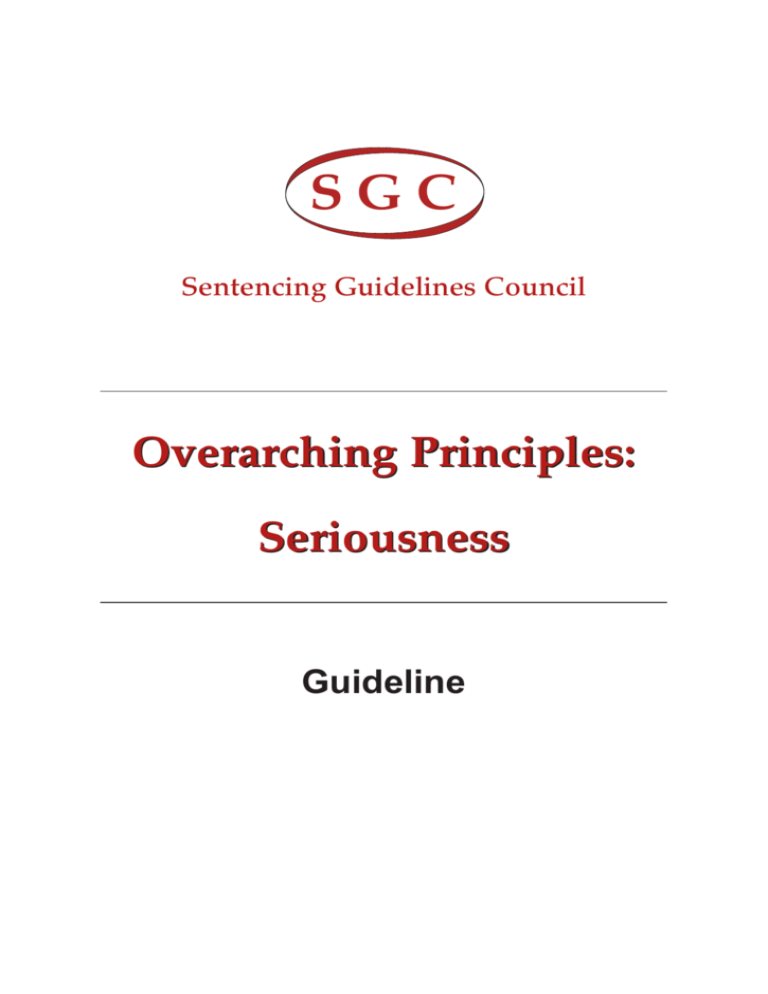Overarching principles: Seriousness
advertisement

SGC Sentencing Guidelines Council Overarching Principles: Principles: Seriousness Seriousness Guideline FOREWORD In accordance with the provisions of section 170(9) Criminal Justice Act 2003, the Sentencing Guidelines Council issues this guideline as a definitive guideline. By virtue of section 172 of the Act, every court must have regard to a relevant guideline. The Council was created in 2004 in order to frame Guidelines to assist Courts as they deal with criminal cases across the whole of England and Wales. The Council has stated that it intends to follow a principled approach to the formulation of guidelines to assist sentencers which will include consideration of overarching and general principles relating to the sentencing of offenders. Following the planned implementation of many of the sentencing provisions in the 2003 Act in April 2005, this guideline deals with the general concept of seriousness in the light of those provisions and considers how sentencers should determine when the respective sentencing thresholds have been crossed when applying the provisions of the Act. This guideline applies only to sentences passed under the sentencing framework applicable to those aged 18 or over although there are some aspects that will assist courts assessing the seriousness of offences committed by those under 18. The Council has commissioned separate advice from the Sentencing Advisory Panel on the sentencing of young offenders. This is the first time that it has been possible to produce definitive guidelines not only before new provisions come into force but also before much of the training of judiciary and practitioners. The Council has appreciated greatly the work of the Sentencing Advisory Panel in preparing the advice on which this guideline has been based and for the many organisations and individuals who have responded so thoughtfully to the consultation of both the Panel and the Council. The advice and this guideline are available on www.sentencing-guidelines.gov.uk or from the Sentencing Guidelines Secretariat. A summary of the responses to the Council’s consultation also appears on the website. Chairman of the Council December 2004 i Sentencing Guidelines Council CONTENTS A Statutory Provisions 3 B Culpability 4 C Harm 4–5 D Assessment of Culpability and Harm (i) Aggravating Factors (ii) Mitigating Factors (iii) Personal Mitigation (iv) Reduction for a Guilty Plea 5–7 6 7 7 7 E The Sentencing Thresholds The Custody Threshold The Threshold for Community Sentences 8–9 8 8–9 F Prevalence 9 1 Sentencing Guidelines Council SERIOUSNESS A. Statutory Provisions 1.1 In every case where the offender is aged 18 or over at the time of conviction, the court must have regard to the five purposes of sentencing contained in section 142(1) Criminal Justice Act 2003: (a) (b) (c) (d) (e) the the the the the punishment of offenders reduction of crime (including its reduction by deterrence) reform and rehabilitation of offenders protection of the public making of reparation by offenders to persons affected by their offence 1.2 The Act does not indicate that any one purpose should be more important than any other and in practice they may all be relevant to a greater or lesser degree in any individual case – the sentencer has the task of determining the manner in which they apply. 1.3 The sentencer must start by considering the seriousness of the offence, the assessment of which will: ❏ determine which of the sentencing thresholds has been crossed; ❏ indicate whether a custodial, community or other sentence is the most appropriate; ❏ be the key factor in deciding the length of a custodial sentence, the onerousness of requirements to be incorporated in a community sentence and the amount of any fine imposed. 1.4 A court is required to pass a sentence that is commensurate with the seriousness of the offence. The seriousness of an offence is determined by two main parameters; the culpability of the offender and the harm caused or risked being caused by the offence. 1.5 Section 143(1) Criminal Justice Act 2003 provides: “In considering the seriousness of any offence, the court must consider the offender’s culpability in committing the offence and any harm which the offence caused, was intended to cause or might foreseeably have caused.” 3 Sentencing Guidelines Council B. Culpability 1.6 Four levels of criminal culpability can be identified for sentencing purposes: 1.7 Where the offender; (i) has the intention to cause harm, with the highest culpability when an offence is planned. The worse the harm intended, the greater the seriousness. (ii) is reckless as to whether harm is caused, that is, where the offender appreciates at least some harm would be caused but proceeds giving no thought to the consequences even though the extent of the risk would be obvious to most people. (iii) has knowledge of the specific risks entailed by his actions even though he does not intend to cause the harm that results. (iv) is guilty of negligence. Note: There are offences where liability is strict and no culpability need be proved for the purposes of obtaining a conviction, but the degree of culpability is still important when deciding sentence. The extent to which recklessness, knowledge or negligence are involved in a particular offence will vary. C. Harm 1.8 The relevant provision is widely drafted so that it encompasses those offences where harm is caused but also those where neither individuals nor the community suffer harm but a risk of harm is present. To Individual Victims 1.9 The types of harm caused or risked by different types of criminal activity are diverse and victims may suffer physical injury, sexual violation, financial loss, damage to health or psychological distress. There are gradations of harm within all of these categories. 1.10 The nature of harm will depend on personal characteristics and circumstances of the victim and the court’s assessment of harm will be an effective and important way of taking into consideration the impact of a particular crime on the victim. 1.11 In some cases no actual harm may have resulted and the court will be concerned with assessing the relative dangerousness of the offender’s conduct; it will consider the likelihood of harm occurring and the gravity of the harm that could have resulted. To the Community 1.12 Some offences cause harm to the community at large (instead of or as well as to an individual victim) and may include economic loss, harm to public health, or interference with the administration of justice. Other Types of harm 1.13 There are other types of harm that are more difficult to define or categorise. For example, cruelty to animals certainly causes significant harm to the animal but there may also be a human victim who also suffers psychological distress and/or financial loss. 4 Sentencing Guidelines Council 1.14 Some conduct is criminalised purely by reference to public feeling or social mores. In addition, public concern about the damage caused by some behaviour, both to individuals and to society as a whole, can influence public perception of the harm caused, for example, by the supply of prohibited drugs. D. The Assessment of Culpability and Harm 1.15 Section 143(1) makes clear that the assessment of the seriousness of any individual offence must take account not only of any harm actually caused by the offence, but also of any harm that was intended to be caused or might foreseeably be caused by the offence. 1.16 Assessing seriousness is a difficult task, particularly where there is an imbalance between culpability and harm: ❏ sometimes the harm that actually results is greater than the harm intended by the offender; ❏ in other circumstances, the offender’s culpability may be at a higher level than the harm resulting from the offence. 1.17 Harm must always be judged in the light of culpability. The precise level of culpability will be determined by such factors as motivation, whether the offence was planned or spontaneous or whether the offender was in a position of trust. Culpability will be greater if: ❏ an offender deliberately causes more harm than is necessary for the commission of the offence, or ❏ where an offender targets a vulnerable victim (because of their old age or youth, disability or by virtue of the job they do). 1.18 Where unusually serious harm results and was unintended and beyond the control of the offender, culpability will be significantly influenced by the extent to which the harm could have been foreseen. 1.19 If much more harm, or much less harm has been caused by the offence than the offender intended or foresaw, the culpability of the offender, depending on the circumstances, may be regarded as carrying greater or lesser weight as appropriate. The culpability of the offender in the particular circumstances of an individual case should be the initial factor in determining the seriousness of an offence. 5 Sentencing Guidelines Council (i) Aggravating Factors 1.20 Sentencing guidelines for a particular offence will normally include a list of aggravating features which, if present in an individual instance of the offence, would indicate either a higher than usual level of culpability on the part of the offender, or a greater than usual degree of harm caused by the offence (or sometimes both). 1.21 The lists below bring together the most important aggravating features with potential application to more than one offence or class of offences. They include some factors (such as the vulnerability of victims or abuse of trust) which are integral features of certain offences; in such cases, the presence of the aggravating factor is already reflected in the penalty for the offence and cannot be used as justification for increasing the sentence further. The lists are not intended to be comprehensive and the aggravating factors are not listed in any particular order of priority. On occasions, two or more of the factors listed will describe the same feature of the offence and care needs to be taken to avoid “double­ counting”. Those factors starred with an asterisk are statutory aggravating factors where the statutory provisions are in force. Those marked with a hash are yet to be brought into force but as factors in an individual case are still relevant and should be taken into account. 1.22 ❏ ❏ ❏ ❏ ❏ ❏ ❏ ❏ ❏ ❏ ❏ ❏ ❏ ❏ ❏ ❏ ❏ ❏ ❏ ❏ ❏ ❏ 6 Factors indicating higher culpability: Offence committed whilst on bail for other offences* Failure to respond to previous sentences# Offence was racially or religiously aggravated* Offence motivated by, or demonstrating, hostility to the victim based on his or her sexual orientation (or presumed sexual orientation)# Offence motivated by, or demonstrating, hostility based on the victim’s disability (or presumed disability)# Previous conviction(s), particularly where a pattern of repeat offending is disclosed # Planning of an offence An intention to commit more serious harm than actually resulted from the offence Offenders operating in groups or gangs ‘Professional’ offending Commission of the offence for financial gain (where this is not inherent in the offence itself) High level of profit from the offence An attempt to conceal or dispose of evidence Failure to respond to warnings or concerns expressed by others about the offender’s behaviour Offence committed whilst on licence Offence motivated by hostility towards a minority group, or a member or members of it Deliberate targeting of vulnerable victim(s) Commission of an offence while under the influence of alcohol or drugs Use of a weapon to frighten or injure victim Deliberate and gratuitous violence or damage to property, over and above what is needed to carry out the offence Abuse of power Abuse of a position of trust Sentencing Guidelines Council 1.23 Factors indicating a more than usually serious degree of harm: ❏ ❏ ❏ ❏ ❏ ❏ Multiple victims An especially serious physical or psychological effect on the victim, even if unintended A sustained assault or repeated assaults on the same victim Victim is particularly vulnerable Location of the offence (for example, in an isolated place) Offence is committed against those working in the public sector or providing a service to the public ❏ Presence of others e.g. relatives, especially children or partner of the victim ❏ Additional degradation of the victim (e.g. taking photographs of a victim as part of a sexual offence) ❏ In property offences, high value (including sentimental value) of property to the victim, or substantial consequential loss (e.g. where the theft of equipment causes serious disruption to a victim’s life or business) (ii) Mitigating factors 1.24 Some factors may indicate that an offender’s culpability is unusually low, or that the harm caused by an offence is less than usually serious. 1.25 ❏ ❏ ❏ ❏ Factors indicating significantly lower culpability: A greater degree of provocation than normally expected Mental illness or disability Youth or age, where it affects the responsibility of the individual defendant The fact that the offender played only a minor role in the offence (iii) Personal mitigation 1.26 Section 166(1) Criminal Justice Act 2003 makes provision for a sentencer to take account of any matters that ‘in the opinion of the court, are relevant in mitigation of sentence’. 1.27 When the court has formed an initial assessment of the seriousness of the offence, then it should consider any offender mitigation. The issue of remorse should be taken into account at this point along with other mitigating features such as admissions to the police in interview. (iv) Reduction for a guilty plea 1.28 Sentencers will normally reduce the severity of a sentence to reflect an early guilty plea. This subject is covered by a separate guideline and provides a sliding scale reduction with a normal maximum one-third reduction being given to offenders who enter a guilty plea at the first reasonable opportunity. 1.29 Credit may also be given for ready co-operation with the authorities. This will depend on the particular circumstances of the individual case. 7 Sentencing Guidelines Council E. The Sentencing Thresholds 1.30 Assessing the seriousness of an offence is only the first step in the process of determining the appropriate sentence in an individual case. Matching the offence to a type and level of sentence is a separate and complex exercise assisted by the application of the respective threshold tests for custodial and community sentences. The Custody Threshold 1.31 Section 152(2) Criminal Justice Act 2003 provides: “The court must not pass a custodial sentence unless it is of the opinion that the offence, or the combination of the offence and one or more offences associated with it, was so serious that neither a fine alone nor a community sentence can be justified for the offence.” 1.32 In applying the threshold test, sentencers should note: ❏ the clear intention of the threshold test is to reserve prison as a punishment for the most serious offences; ❏ it is impossible to determine definitively which features of a particular offence make it serious enough to merit a custodial sentence; ❏ passing the custody threshold does not mean that a custodial sentence should be deemed inevitable, and custody can still be avoided in the light of personal mitigation or where there is a suitable intervention in the community which provides sufficient restriction (by way of punishment) while addressing the rehabilitation of the offender to prevent future crime. For example, a prolific offender who currently could expect a short custodial sentence (which, in advance of custody plus, would have no provision for supervision on release) might more appropriately receive a suitable community sentence. 1.33 The approach to the imposition of a custodial sentence under the new framework should be as follows: (a) has the custody threshold been passed? (b) if so, is it unavoidable that a custodial sentence be imposed? (c) if so, can that sentence be suspended? (sentencers should be clear that they would have imposed a custodial sentence if the power to suspend had not been available) (d) if not, can the sentence be served intermittently? (e) if not, impose a sentence which takes immediate effect for the term commensurate with the seriousness of the offence. The Threshold for Community Sentences 1.34 Section 148(1) Criminal Justice Act 2003 provides: “A court must not pass a community sentence on an offender unless it is of the opinion that the offence, or the combination of the offence and one or more offences associated with it, was serious enough to warrant such a sentence.” 8 Sentencing Guidelines Council 1.35 In addition, the threshold for a community sentence can be crossed even though the seriousness criterion is not met. Section 151 Criminal Justice Act 2003 provides that, in relation to an offender aged 16 or over on whom, on 3 or more previous occasions, sentences had been passed consisting only of a fine, a community sentence may be imposed (if it is in the interests of justice) despite the fact that the seriousness of the current offence (and others associated with it) might not warrant such a sentence. 1.36 Sentencers should consider all of the disposals available (within or below the threshold passed) at the time of sentence before reaching the provisional decision to make a community sentence, so that, even where the threshold for a community sentence has been passed, a financial penalty or discharge may still be an appropriate penalty. Summary 1.37 It would not be feasible to provide a form of words or to devise any formula that would provide a general solution to the problem of where the custody threshold lies. Factors vary too widely between offences for this to be done. It is the task of guidelines for individual offences to provide more detailed guidance on what features within that offence point to a custodial sentence, and also to deal with issues such as sentence length, the appropriate requirements for a community sentence or the use of appropriate ancillary orders. Having assessed the seriousness of an individual offence, sentencers must consult the sentencing guidelines for an offence of that type for guidance on the factors that are likely to indicate whether a custodial sentence or other disposal is most likely to be appropriate. F. Prevalence 1.38 The seriousness of an individual case should be judged on its own dimensions of harm and culpability rather than as part of a collective social harm. It is legitimate for the overall approach to sentencing levels for particular offences to be guided by their cumulative effect. However, it would be wrong to further penalise individual offenders by increasing sentence length for committing an individual offence of that type. 1.39 There may be exceptional local circumstances that arise which may lead a court to decide that prevalence should influence sentencing levels. The pivotal issue in such cases will be the harm being caused to the community. It is essential that sentencers both have supporting evidence from an external source (for example the local Criminal Justice Board) to justify claims that a particular crime is prevalent in their area and are satisfied that there is a compelling need to treat the offence more seriously than elsewhere. The key factor in determining whether sentencing levels should be enhanced in response to prevalence will be the level of harm being caused in the locality. Enhanced sentences should be exceptional and in response to exceptional circumstances. Sentencers must sentence within the sentencing guidelines once the prevalence has been addressed. 9 Published by the Sentencing Guidelines Secretariat, December 2004






